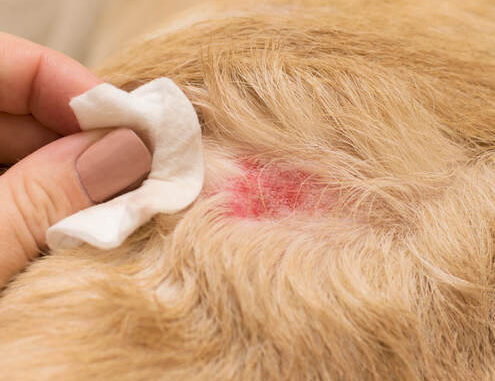
This article was updated on August 3rd, 2023
Any pet parent can tell you that shedding comes along with owning a dog. And while it’s completely normal to find the occasional dog hair in your coffee, excessive hair loss (known as alopecia) is not. If your furry family member appears to be shedding more than usual, you notice generalized hair thinning, the appearance of bald patches, or hair loss accompanied by other changes to the skin (such as itchiness, redness, scabs, or bumps), it may be an indication of an underlying medical issue. Let’s explore possible causes of this common condition and how your vet may recommend treating it.
What do we consider a clump of hair?
A clump of hair refers to a grouping of multiple strands of hair that a dog might be losing – seemingly at once, for example, when brushing your dog. Clumps of hair can be formed naturally and fall out during shedding or grooming, or they can be the result of an underlying medical condition.
When to worry about a dog losing clumps of hair
Dogs, like humans, undergo a natural cycle of hair growth and shedding. This process helps them maintain a healthy coat and regulate body temperature. If your dog starts to lose more hair than usual, develops bald spots or other changes to their skin, or you feel concerned, it may indicate an issue that needs veterinary attention.
What are the common reasons for the loss of clumps of hair in dogs?
Alopecia refers to partial or complete hair loss in areas where hair is normally present. This can occur in patterns or randomly across your dog’s body. Hair loss itself is simply a symptom of an underlying issue. Various factors, including genetics, diet, and overall health can influence whether a dog develops alopecia. Some of these conditions are congenital (a dog is born with them), while others are acquired later in life. Hair loss can occur due to destruction or damage of the hair follicle (for example, due to infection) or disruption of hair follicle growth (for example, due to hormonal imbalances). Another way to help categorize the causes of alopecia is whether or not the hair loss is accompanied by itchy skin.
1. Top causes of hair loss with itchy skin
Allergies (food, environmental, flea)
Dogs can be allergic to certain foods, substances in their environment (such as pollen or dust mites), and even to fleabites. This often leads to intense itching and scratching, causing hair loss, trauma to the skin, and recurrent skin and ear infections. Affected dogs may have red, inflamed skin and will frequently lick or chew at the irritated areas.
If allergies are the culprit, your vet can help you determine the best treatment options. This may include additional testing to determine the underlying cause, treating any skin and ear infections that are present with oral or topical antibiotics or antifungals, consistent flea prevention, a hydrolyzed protein diet, and medications such as Apouel or Cytopoint to help manage clinical signs.
The image below shows hair loss along with red, irritated, and infected skin secondary to allergies.
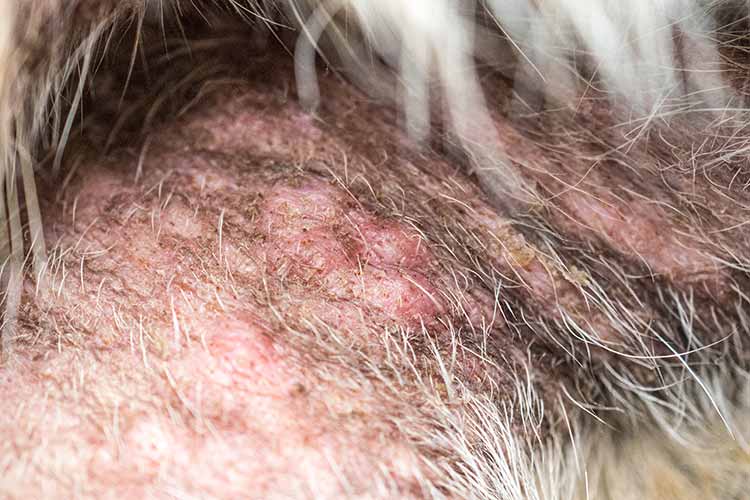
Parasites (mites, fleas)
Parasites such as fleas or mites can have a significant impact on your dog’s skin. Demodectic mange is caused by a mite and can lead to areas of patchy hair loss (especially around the face and eyes), in puppies or immunocompromised adult or senior dogs. Sarcoptic mange is a highly contagious mite that causes intense itching and hair loss. These conditions can also lead to secondary skin infections. Your vet will be able to diagnose fleas based on a physical exam and the presence of live fleas or flea dirt. To determine if mites are present, they may collect a skin scraping to evaluate under the microscope. Treatment options include prescription oral or topical medications.
The first image below depicts patchy hair loss on the face typical of a puppy with Demodex, while the second is an example of a generalized mite infestation and secondary infection.
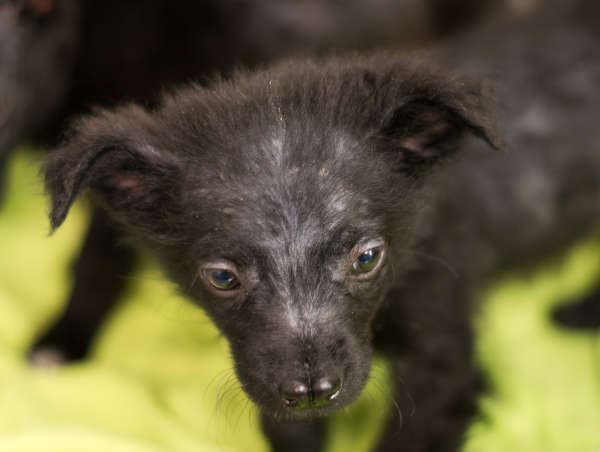
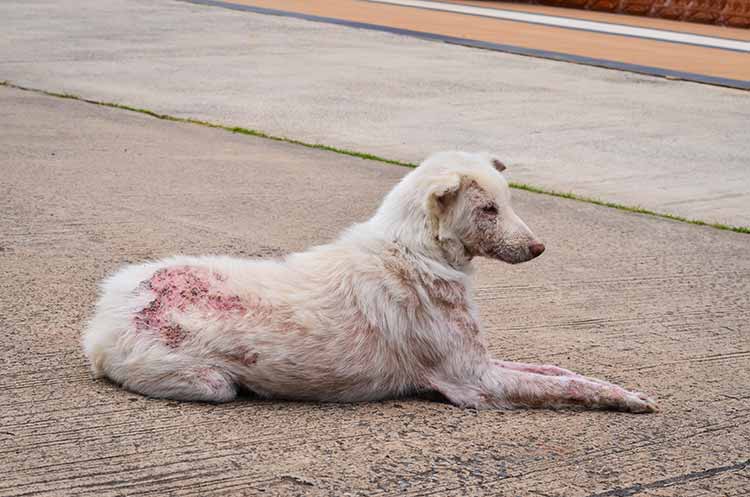
Skin infection or inflammation (dermatitis)
Skin infections can be caused by bacteria, yeast, or fungus, and lead to inflammation of the skin. Infections may result from an underlying issue such as allergies or parasites, or a contagious condition such as ringworm. Common clinical signs include redness, hair loss, scabbing, pustules (pimples), and itchy skin. Cytology (examining a sample from the skin under a microscope) and/or culture (growing the bacteria or organism that is present), can be used to diagnose a skin infection and help your vet choose an appropriate topical or oral medication, such as antibiotics.
Hot spots or acute moist dermatitis
Hot spots are painful, swollen, red areas of hair loss that occur on a dog’s skin. They can occur due to an allergic reaction, fleas, or even due to stress, and are exacerbated by self-trauma from scratching, biting, and licking excessively. These hot spots can quickly become large and are often associated with hair loss, skin infection, and discomfort, thus requiring a veterinary exam and treatment (often consisting of clipping and cleaning the area, topical medications, antibiotics, anti-inflammatories, and an E-collar to prevent additional damage). View more pictures of hot spots in dogs (with our veterinarian team’s advice).
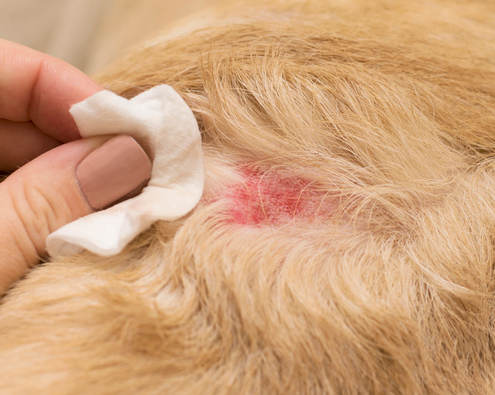
2. Top causes of hair loss without itchy skin
Seasonal shedding
While all dogs shed, it may be more noticeable in some dogs than others or at certain times of the year. If your dog appears to be shedding excessively but it is NOT accompanied by other clinical signs or the development of bald patches, it may be normal. If you ever have questions or concerns, it is best to see your vet.
Hormonal imbalance
Hypothyroidism, a condition in which the thyroid gland doesn’t produce enough hormones, can lead to hair loss, lethargy, weight gain, and a dull hair coat. Cushing’s disease (hyperadrenocorticism), on the other hand, is caused by an overproduction of the stress hormone cortisol. It often results in thinning hair, darkened skin, a pot-bellied appearance, and increased thirst and urination. These conditions can be diagnosed through blood tests and managed with medications.
The image below is a dog with Cushing’s Disease. Note the thinning fur coat. You can also view these other Cushing disease pictures on BowWowInsurance.com.

Genetic conditions
Certain breeds are prone to hair loss; for example, Doberman Pinchers, among other short-coated breeds, are predisposed to color dilution alopecia. This condition leads to brittle hair that easily falls out, often in a symmetrical pattern around the ears, neck, trunk, and thighs.
Alopecia X, most commonly seen in Pomeranians and other Nordic breeds, is a progressive condition that may lead to complete hair loss. Diagnosis is made by skin biopsy, but luckily this condition is cosmetic only and does not typically cause other issues.
Below is an image of alopecia X in a Pomeranian.

Stress
In some cases, dogs may lick, chew, or scratch excessively due to stress, anxiety, or pain, resulting in an acral lick granuloma. Temporary hair loss can also occur during pregnancy, lactation, or following a severe illness when there are large amounts of stress placed on the body.
Other
Other conditions, such as immune-mediated disease or cancer. are also possible causes of alopecia.
Early symptoms and signs associated with clumps of hair falling out
The appearance of hair loss and accompanying clinical signs can vary greatly depending on the underlying cause. Additional symptoms that may occur with hair loss include:
- Pruritus (itchy skin) leading to excessive chewing, scratching, or licking
- Redness, scabbing, pustules, scales, pigmentation, or other changes to the appearance of the skin
- Recurrent skin infections and ear infections
- Systemic signs such as lethargy, weight gain, and increased thirst and urination
Can I treat my dog’s hair loss at home?
It is best to see a vet for diagnostics and treatment of alopecia. This condition is generally not an emergency but can be itchy and uncomfortable. There are many possible causes, so your vet will need to perform an exam and diagnostics to ensure that they provide your pup with appropriate treatment. You may consider the following while waiting for your veterinary appointment:
- Make sure that all pets in the household are on a safe and appropriate monthly flea prevention.
- Put an e-collar on your dog to prevent further damage due to scratching, chewing, or licking.
- Mild skin infections may respond to weekly bathing with a medicated shampoo, such as the one listed below.
- #1 non-prescription topical brand used and recommended by U.S. veterinarians for dogs and cats with infections/inflammatory dermatological disease
- Consult your veterinarian about other possible home remedies and appropriate dosages of Benadryl, omega-3 fish oil, vitamin E, and melatonin.
- WHY OMEGA-3 PET - This Nordic Naturals pet product is made with the same exceptional quality oil as our human products, but has been specially formulated for your dog. Omega-3 Pet features omega-3 fish oil in soft gels.
- If environmental allergies are suspected, it can be helpful to wipe down your dog’s paws after they come in from outside.
When to visit the vet
In most cases, hair loss is a sign of an underlying medical issue and will require veterinary diagnostics and treatment. While these cases are rarely life-threatening emergencies (luckily), if your dog is itchy, painful, or uncomfortable it is best to schedule an appointment as soon as possible.
Treatment options for dogs whose hairs fall out
In order to ensure that your pup is treated appropriately, your vet will first need to determine the underlying cause of their hair loss. This may include some or all of the following:
- Thorough history – It is important that you provide your vet with details about your dog’s symptoms and lifestyle, including how long the hair loss has been going on, if your dog appears itchy, their current diet, and any other health concerns.
- Nose-to-tail physical exam – During this exam, your vet will evaluate your dog’s skin and hair to look for evidence of skin infection or parasites, lesions on the skin, and the distribution and appearance of the hair loss.
- Skin cytology – Your vet may collect a sample from the skin for evaluation under the microscope. This may be done by pressing a glass microscope slide against the skin or using a piece of tape to collect skin cells. In the case of an ear infection, they will take a swab of debris from your dog’s ear. Evaluation under the microscope should determine if it is yeast, bacteria, or both that are causing the infection.
- Bacterial or fungal culture – This can be used to grow the organism that is causing infection and help determine which medications it will respond to.
- Skin scraping – This is another way to collect a small skin sample to look for the presence of mites (Demodex or Scabies) under the microscope.
- Biopsy – In more severe cases or those resistant to treatment, a larger piece of skin may be removed via a punch biopsy for evaluation by a specialist.
- Bloodwork – Routine bloodwork and urine testing will help your vet evaluate your dog’s overall systemic health. They may also recommend additional testing to check your dog’s thyroid function and test for Cushing’s Disease.
- Allergy testing or hydrolyzed protein diet trial – These options may be recommended to diagnose underlying food or environmental allergies.
Treatment may include:
- Oral medications – such as antibiotics, antifungals, anti-parasiticides, and medications to help control inflammation and itchy skin such as steroids, Apoquel, or Cytopoint
- Topical therapy – such as medicated shampoos, wipes, sprays, or ointments
- Treatment of hypothyroidism and Cushing’s disease with oral medications
- Change in diet for dogs with food allergies
- In some cases, no treatment may be needed, while in others referral to a specialist may be recommended.
Frequently Asked Questions
How do I know if my dog’s hair loss is a serious problem?
While all dogs shed, normal shedding should not result in bald spots or a generalized thinning fur coat. Additionally, if your dog is displaying other symptoms such as red itchy skin, skin lesions, changes in weight, energy level, appetite, thirst, and urination, a veterinary visit is in order.
Should I be concerned if my dog’s hair loss is seasonal?
If hair loss is seasonal, it could be due to normal shedding or a seasonal medical condition such as environmental allergies. In addition, some dogs develop a condition known as seasonal flank alopecia, which results in symmetrical hair loss and darkened skin on the flanks (the area just in front of the rear legs). If the seasonal hair loss is bothering you or your dog, please schedule an appointment with your vet.
Can hair loss in dogs be prevented?
Hair loss cannot always be prevented; however, it is important to keep your dog up to date on flea prevention, provide breed-appropriate grooming, and feed a high quality complete and balanced diet.
Are there any specific breeds that are more prone to hair loss?
Some breeds are more prone to developing genetic causes of alopecia, for example, Doberman Pinchers, Pomeranians, Huskies, and other short-coated and Nordic breeds. Additionally, allergies are frequently seen in breeds such as Golden Retrievers and Bulldogs.
How long does it take for a dog’s hair to grow back?
This will vary based on the underlying cause and the severity of hair loss. Hair will not regrow until the underlying issue has been treated. After this, it may take 1-4 months for the hair to fully regrow. In some cases, such as Alopecia X, normal hair may never regrow.
Related posts:
Disclaimer: This website's content is not a substitute for veterinary care. Always consult with your veterinarian for healthcare decisions. Read More.





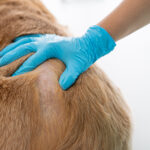
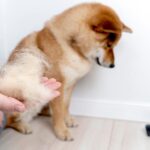
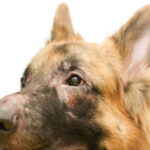
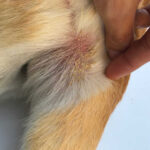
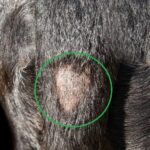

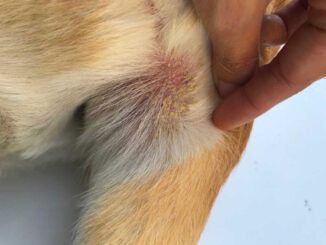
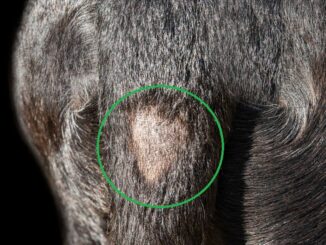

Be the first to comment